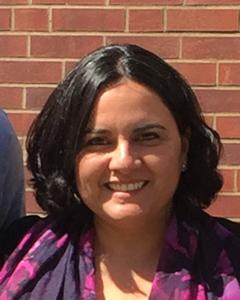
Pharmacy innovator Sandra Leal, PharmD, MPH, addressed PharmD students at the UI College of Pharmacy today, urging them to seek out their own pioneering paths in the field.
Leal is the vice president for innovation at SinfoníaRx in Tucson, Ariz., a provider of medication therapy management services nationally.
Great Opportunity, and a Significant Barrier for Pharmacists
She told students that pharmacists have proven themselves to be vital members of health care teams, which are growing as overall patient needs increase. “There are 10,000 patients per day that are entering the Medicare system,” said Leal. “And so many people are living longer. They have more medications, and there is a lot of opportunity to make an impact in what we do.”
Despite pharmacists contributing more than ever to clinical work and being integrated into patient teams, though, payment has not always followed, said Leal. “Pharmacists have historically only gotten paid by dispensing medication, but (this doesn’t help) if you’re in a clinical setting where you don’t dispense medication,” Leal added.
“Pharmacists have historically only gotten paid by dispensing medication, but (this doesn’t help) if you’re in a clinical setting where you don’t dispense medication,”
She asked the students to advocate for provider status for pharmacists. There are two bills in Congress, she said, that if signed into law, “then that would take a significant barrier away from you when you go out to practice. You could actually bill like any other provider. So a physician assistant, a nurse practitioner, or (a) physician … can contract with a payer and anything they do clinically they get paid for. Right now, a pharmacist (can do) almost exactly the same work, but because we’re not on the provider list we don’t get paid.”
Pharmacists are the Most Accessible Health Professionals
Leal said that growing up in the border town of Nogales, Ariz., she went to a pharmacist in Mexico for her primary care. “I actually used to think that the pharmacist was the primary care clinician,” said Leal. Although pharmacy in the United States operates differently, it doesn’t change the fact that “in many instances, the pharmacist is the first person that people go in to (see to) access care,” she added. "We try to reach people the way they want to be reached.”
Pharmacists are gaining authority to improve the health of people who come into pharmacies, she said. “You’re going to have more ability to think clinically, increase access, and impact public health.” By providing vaccines and other new services, pharmacists are critically impacting public health, Leal said.
Innovation in the Field
Other newer services pharmacists provide are tele-health—best used to improve access to pharmacists; serving on teams that prevent people discharged from a hospital from being readmitted; and in other innovative roles, she said. SinfoníaRx has started to use pharmacogenomics to test whether a patient’s medication regimen is being used appropriately, given his or her genetic makeup. In another project, the company is tracking if anxiety and depression levels fall in patients who play a gaming app for smartphones.
Advice for Students
For the first ten years of your career, don’t say no to anything.
Leal paid forward advice she got along her professional journey: “For the first ten years of your career, don’t say no to anything. Say yes and then hopefully it leads you down a path where you’ll have opportunities to network and create a professional career that you really love and enjoy,” she told the students. “I wake up some days and go to work and I can’t believe that I get paid to do what I do.”
Leal has extensive experience setting up partnerships with payers and providers for pharmacy services.
Separately during her visit, she presented to faculty on the topic: “Current and Future Directions of Pharmacy Services Reimbursement.”
At SinfoníaRx, Leal works to establish integrated clinical pharmacy services in a variety of programs including a hospital discharge program, integrated behavioral health clinics, accountable care organizations and patient-centered medical homes. She uses tele-health and other strategies to scale resources to communities, clinicians, and patients.